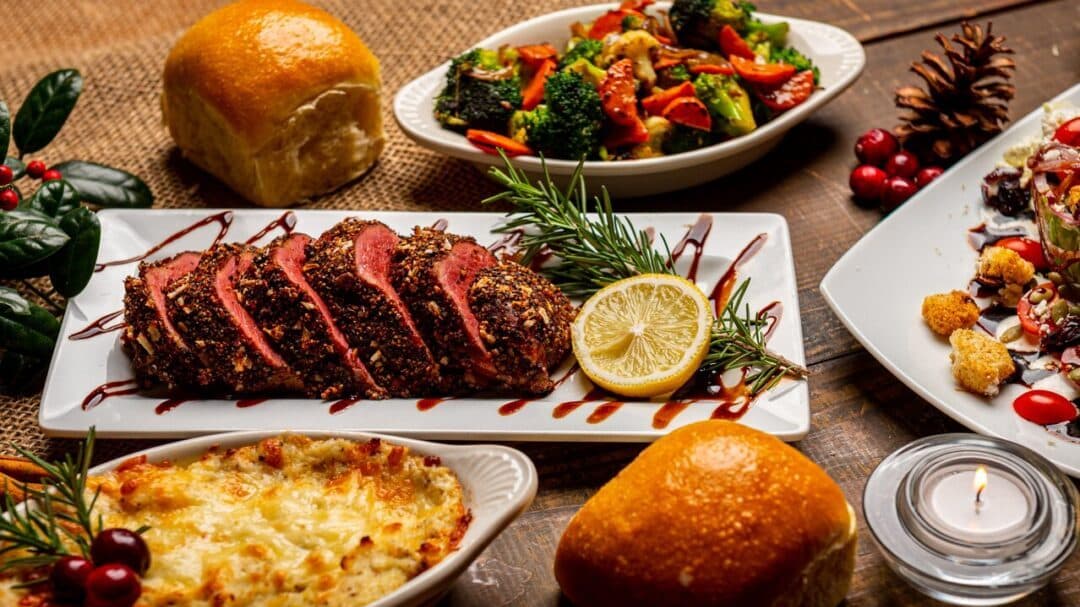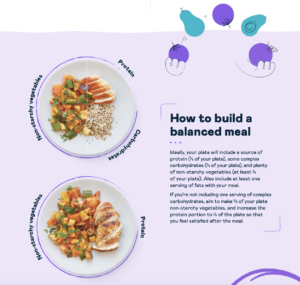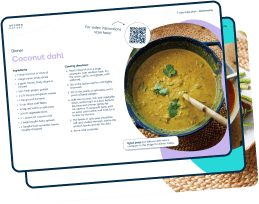Jump to: Five ways to make Christmas dinner healthy | Cook and cool your roast potatoes | Make your gravy from scratch | Cook with extra virgin olive oil | Pile on the veggies | Balance your plate | Take home message
Lifestyle
Christmas food: Five ways to make it healthy
Written by
Robbie Puddick (RNutr)
Content and SEO Lead
Medically reviewed by
Dr Rachel Hall (MBCHB)
Principal Doctor
7 min read
Last updated December 2025

Medication-assisted weight loss with a future focus
Start with Wegovy or Mounjaro, transition to habit-based health with our support


Five ways to make your Christmas food healthy:
- Cook and cool your potatoes.
- Make your gravy from scratch.
- Cook with extra virgin olive oil.
- Pile on the vegetables.
- Balance your plate: 25% carbs, 25% protein, 50% vegetables, and at least one serving of fat.
Christmas food is delicious. There’s no getting away from the luxury of roast turkey or roast chicken (or lentil and nut roast for vegans and veggies), cranberry sauce, Brussels sprouts, crispy potatoes, vegetables, cauliflower cheese, and Christmas desserts to boot.
However, there’s a misconception that food on Christmas day is inherently unhealthy because we often overindulge at Christmas. This couldn’t be further from the truth; Christmas food has the potential to be highly health-promoting – you just need to know how to prepare it.
Click here to jump straight to our five tips for making a healthier Christmas dinner for the whole family.
Now, it’s important to highlight that your health won’t be defined by the food you eat over Christmas.
It’s a very short time of the year, and your health will result from your habits over the long term, not just during the holiday season and the work Christmas party.
Avoid the all-or-nothing mindset
We can often fall into the all-or-nothing mindset where we might overindulge on one occasion and think, “what the hell” and continue with the mindset that we might as well continue to overindulge because we’ve already ruined our eating habits.
This simply isn’t true. Consider this analogy, you’re driving in your car, and you get a flat tyre. Are you going to throw the rest of your tyres into the bin because one of them has gone flat? No.
You’re going to think, “that’s OK; one tyre might have gone flat, but the rest of them are still OK; I can simply replace this one and move on with my journey”. You can approach food in the same way.
So, if you do overindulge this Christmas, rather than thinking you’ve ruined everything and fallen off the wagon, tell yourself that it’s OK, it’s normal to overeat sometimes (particularly over Christmas), and this is no reason to think you can’t continue eating healthy meals after.
At Second Nature, you’ve always got a registered dietitian or nutritionist to support you, even over the holidays.
When you feel like you’ve failed or you’ve fallen off the wagon, the Second Nature health coaches are on hand to offer you support, guidance, and reassurance.
You can click here to take our health quiz if you’re ready to join 150,000 others who’ve ditched the diet mentality and moved away from the all-or-nothing mindset.
Otherwise, keep reading if you’re looking for ways to make your Christmas dinner healthier and more nutritious; we’ve got five top tips from our registered dietitians and nutritionists that will make your food healthier and probably more delicious.
Five ways to make your Christmas dinner healthier this year
1) Cook and cool your roast potatoes
Cooking and cool starches like potatoes increase the amount of ‘resistant starch’ within the potato. This also works with sweet potatoes.
As the name suggests, resistant starch is more resistant to digestion in our body and tends to get eaten up by our gut bacteria instead.
This means less energy digested into your body to possibly be stored as fat if it’s not burnt for energy and more food for your gut bacteria.
Here’s how to do it:
- Peel your potatoes as usual (Maris Piper is an excellent option for roasties – save your peelings for bubble and squeak).
- Chop them up into your favourite roast potato shapes.
- Par-boil them on high heat for 5-7 minutes until they start to turn soft.
- Pour them into a colander and shake around the roughen up the outside.
- Leave to the side to cool for a couple of hours.
Second Nature top tip: You can do this the day or two before the big day and leave them in the fridge.
2) Make your gravy from scratch
It’s often too easy to put the kettle on and use an instant gravy ready to hit the table in five minutes. Sometimes, it’s just what you need when you’re short of time, and they don’t taste half bad.
But when you’ve got some extra time over Christmas, why not spend half an hour making a delicious homemade gravy?
Using fresh chicken stock made from a carcass, or vegetable stock made from the leftover vegetables, you can have a healthy, delicious gravy ready and waiting in the fridge for the big day. The fresh stock will provide a depth of flavour and essential nutrients.
Here’s how to do it:
- Have 500ml-1l of fresh chicken or vegetable stock ready. (If you haven’t made your own stock, cubes made with boiling water will do fine.)
- Melt 30-50g butter in a pan on medium heat.
- Add 1-2 tablespoons of cornflour (gluten-free) and stir with a wooden spoon or whisk; cook off the flour for 2-3 minutes.
- Turn the heat down and add the stock, stirring well with a whisk. You may see some chunks of flour, but that’s OK – you’ll be straining it off at the end.
- Optional: add a tablespoon of soy sauce or Bovril to add a depth of flavour and darken the colour.
- Bring to a boil, allow to simmer for 20 minutes, and run through a sieve into a jug to serve.
Second Nature top tip: You can prepare this in advance and leave it in the fridge ready.
3) Cook with extra virgin olive oil
There’s a prevailing myth that extra virgin olive oil isn’t a good option for cooking and that we should use the cheaper refined oils as they have a lower smoke point.
This turns out not to be accurate. High-quality research has shown that extra virgin olive oil is much more stable under medium to higher cooking temperatures than cheap refined oils such as sunflower or vegetable oils.
Extra virgin olive oil brings a variety of health benefits. It’s been shown to be a potent anti-inflammatory and supports a reduced risk of developing cardiovascular disease.
So, whether you’re roasting your potatoes, vegetables, or chicken or frying off some onions – extra virgin olive oil is an excellent choice.
You might think that extra virgin olive oil is much more expensive, but fortunately, most supermarkets are now providing home-brand extra virgin olive oil for more affordable prices.
They’re still a bit more expensive than the refined oils, but we feel it’s one part of your food bill worth paying a bit more for.
Here’s a breakdown of the costs of extra virgin olive oil at standard UK supermarkets:
- Asda: £5.10 1l (51p per 100ml)
- Tesco: £3.20 500ml (64p per 100ml)
- Lidl: £3.90 1L (39p per 100ml)
Second Nature top tip: If you can buy in bulk, the larger tins of extra virgin olive oil often come through at less than 50p per 100ml at most supermarkets. And if you pass a Lidl or Aldi, take advantage of the lower prices and stock up!
4) Pile on the veggies
Vegetables are packed with fibre, micronutrients, and water. Eating them in a meal leads to your stomach expanding; we call this stomach distension.
Stomach distension sends an early signal to your brain, letting it know you’re getting to the point of fullness and have eaten enough.
So, by bulking out your Christmas dinner with plenty of vegetables, you’ll reach a comfortable feeling of fullness without overeating.
Some vegetables are great for roasting, while others are great for steaming or braising. Here’s a quick list of our favourite vegetables and how we’d recommend cooking them:
Roasting (in olive oil)
- Carrots
- Parsnips
- Butternut squash (serve with roasted pecans or chestnuts)
- Beets
Steaming (drizzle olive oil or melt butter after)
- Broccoli
- Cauliflower
- Green beans
- Peas
Braising or sautéing
- Red cabbage with red wine and pomegranate
- Kale with lemon juice and chilli
- White cabbage and spring greens with garlic and lime juice
- Brussels sprouts with chopped bacon
Second Nature tip: A lot of the vegetable and side dishes can be prepped the day before, and it might enhance their flavour.
5) Balance your plate
Having the right balance of protein, fat, carbohydrates, and vegetables in your meal will ensure you’re giving your body everything it needs and enjoying the variety of flavours, textures, and aromas.
Our healthy plate model can be used to build any meal, and Christmas dinner is no exception, try keeping this in mind when serving up your meals. (If you right-click on the image, you can save it to your phone or computer and print it out to keep on the fridge at home.)

Second Nature tip: Research has suggested that by eating your protein and fibre (vegetables) first and your carbs last, you can prevent a larger spike in blood sugar levels which can often lead to feelings of hunger later in the day.
A prawn cocktail could be the perfect appetiser!
Take home message
You don’t need to enter the Christmas period thinking about perfection. It’s a time of year to savour, be present, and enjoy.
However, it can also be an excellent opportunity to start or continue healthy cooking habits that will add a depth of flavour to your meals and likely boost your health.
If you want to be inspired, join 30,000 monthly visitors and browse some of our healthy Christmas recipes here.
Medication-assisted weight loss with a future focus
Start with Wegovy or Mounjaro, transition to habit-based health with our support



Download our free, indulgent 7-day meal plan
It includes expert advice from our team of registered dietitians to make losing weight feel easier. Subscribe to our newsletter to get access today.
You might also like
As seen on
As seen on
